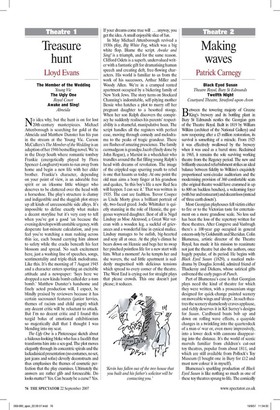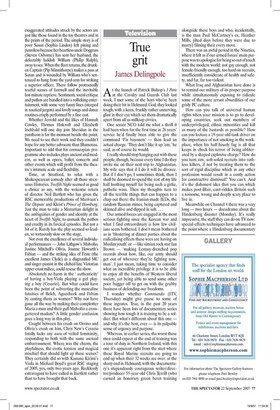Making waves
Patrick Camegy Black Eyed Susan Theatre Royal, Bury St Edmunds Twelfth Night Courtyard Theatre, Stratford-upon-Avon Between the towering majesty of Greene King's brewery and its bottling plant in Bury St Edmunds nestles the Georgian gem of the Theatre Royal. Built in 1819 by William Wilkins (architect of the National Gallery) and now reopening after a £5 million restoration, its survival is something of a miracle. From 1925 it was effectively swallowed by the brewery when it was used as a ban-el store. Reclaimed in 1965, it remains the sole surviving working theatre from the Regency period. The new and brilliantly executed refurbishment strikes an ideal balance between fidelity to Wilkins's exquisitely proportioned semi-circular auditorium and the modernising provision of 360 comfortable seats (the original theatre would have crammed in up to 800 on backless benches), a welcoming foyer (with bar and restaurant) and decent loos (instead of 'three earth closets).
Most Georgian playhouses fell victim either to fire or to the Victorian taste for entertainment on a more grandiose scale. No less sad has been the loss of the repertory written for these theatres. After Congreve and Vanbrugh there's a 100-year gap occupied in general esteem only by Goldsmith and Sheridan. Colin Blumenau, artistic director of the Theatre Royal, has made it his mission to reanimate not just the theatre but also the authors, once hugely popular, of its period. He begins with Black Eyed Susan (1829), a nautical melodrama by Douglas Jerrold, admired friend of Thackeray and Dickens, whose satirical gifts enlivened the early pages of Punch.
Part of Blumenau's case is that Georgian plays need the kind of theatre for which they were written, with a proscenium stage designed for quick-change painted scenery on moveable wings and 'drops'. In such theatres the scenery shamelessly craves applause, and richly deserves it in Kit Surrey's designs for Susan. Cardboard boats bob up and down on rolling wave effects, a quayside changes in a twinkling into the quarterdeck of a man-o'-war or, even more impressively, into a lower deck with cannons disappearing into the distance. It's the world of scenic marvels familiar from children's cut-out toy theatres, popular from about 1811, and which are still available from Pollock's Toy Museum (I bought one in Bury for £12 and must now colour it in myself).
Blumenau's sparkling production of Black Eyed Susan is like nothing so much as one of these toy theatres sprung to life. The comically exaggerated attitudes struck by the actors are just like those found in the toy theatres and in the prints of the period. The simple story is of poor Susan (Sophia Linden) left pining and penniless because her heartless uncle Doggrass (Steven Osborne) has sent her husband, the delectably laddish William (Philip Ralph), away to sea. When the fleet returns, the drunken Captain (Pip Minnithorpe) makes a pass at Susan and is wounded by William who's sentenced to hang from the yard-arm for striking a superior officer. There follow protractedly tearful scenes of farewell and the inevitable last-minute reprieve. Sentiment, social critique and pathos are bundled into a rollicking entertainment, with some very funny lines (steeped in nautical jargon) and lovely songs and dance routines crisply performed by a fine cast.
Whether Jerrold and the likes of Hannah Cowley, Thomas Holcroft and Elizabeth Inchbald will one day join Sheridan in the pantheon is for the moment beside the point. We need to see their work and they couldn't hope for any better advocate than Blumenau. Important to add that his cornucopian programme also includes plays ancient and modern, as well as opera, ballet, concerts and other events which will profit from the theatre's intimate scale and flexibility.
Time, at Stratford, to relax with a Shakespearean comedy after all those strenuous Histories. Twelfth Night seemed as good a choice as any, with the welcome return of director Neil Bartlett who has given the RSC memorable productions of Marivaux's The Dispute and Kleist's Prince of Homburg. Just the man to take a Mozartian delight in the ambiguities of gender and identity at the heart of Twelfth Night, to unmask the pathos and cruelty in its farcical episodes. But not a bit of it. Rarely has the play seemed so leaden, so tortuously slow on the stage.
Not even the excellence of several individual performances — John Lithgow's Malvolio, Justine Mitchell's Olivia, Joanne Howarth's Fabian — and the striking idea of Feste (the excellent James Clyde) as a disgruntled MC and singer-pianist in the cliched late Victorian upper-crust milieu, could rescue the show.
Absolutely no harm in the authenticity' of having a boy-Viola playing a girl playing a boy (Cesario). But what could have been the point of subverting the masculine fatuities of Belch, Aguecheek and Fabian by casting them as women? Why not have gone all the way by making their complotter Maria a man and their gull Malvolio a crossgartered madam? A little gender confusion goes a long way in this play.
Caught between his crush on Orsino and Olivia's crush on him, Chris New's Cesario fatally lacks any aura of veiled femininity, responding to both with the same asexual embarrassment. Where was the charm, the playfulness, the erotic tension and magical mischief that should light up these scenes? They certainly did so with Kananu Kirimi's Viola in Michael Boyd's great RSC staging of 2005; yes, only two years ago. Recklessly extravagant to have called in Bartlett rather than to have brought that back.


































































 Previous page
Previous page